
LINEAR EQUATIONS
An equation is solved by finding a number that is equal to an unknown variable.
Simple Rules for Working with Equations
1. The equal sign separates an equation into two sides.
2. Whenever an operation is performed on one side, the same operation must be performed on the other
side.
3. Your first goal is to get all of the variables on one side and all of the numbers on the other.
4. The final step often will be to divide each side by the coefficient, leaving the variable equal to a
number.
CROSS-MULTIPLYING
You can solve an equation that sets one fraction equal to another by cross-multiplication. Cross-
multiplication involves setting the products of opposite pairs of terms equal.
Example
6
x
=
x+
12
10
becomes 12x= 6(x) + 6(10)
12x= 6x+ 60
−6x−6x
6
6
x
=
6
6
0
Thus, x= 10
Checking Equations
To check an equation, substitute the number equal to the variable in the original equation.
Example
To check the equation from the previous page, substitute the number 10 for the variable x.
6
x
=
x+
12
10
1
6
0
=
10
1
+
2
10
1
6
0
=
2
1
0
2
Simplify the fraction on the right by dividing the numerator and denominator by 2.
1
6
0
=
1
6
0
Because this statement is true, you know the answer x= 10 is correct.
–ACT MATH TEST PRACTICE–
149

Special Tips for Checking Equations
1. If time permits, be sure to check all equations.
2. Be careful to answer the question that is being asked. Sometimes, this involves solving for a variable
and than performing an operation.
Example: If the question asks for the value of x−2, and you find x= 2, the answer is not 2, but
2 −2. Thus, the answer is 0.
CHARTS, TABLES, AND GRAPHS
The ACT Math Test will assess your ability to analyze graphs and tables. It is important to read each graph
or table very carefully before reading the question. This will help you to process the information that is pre-
sented. It is extremely important to read all of the information presented, paying special attention to head-
ings and units of measure. Here is an overview of the types of graphs you will encounter:
■CIRCLE GRAPHS or PIE CHARTS
This type of graph is representative of a whole and is usually divided into percentages. Each section of the
chart represents a portion of the whole, and all of these sections added together will equal 100% of the
whole.
■BAR GRAPHS
Bar graphs compare similar things with bars of different length, representing different values. These graphs
may contain differently shaded bars used to represent different elements. Therefore, it is important to pay
attention to both the size and shading of the graph.
Fruit Ordered by Grocer
100
80
60
40
20
0
Pounds Ordered
Week 1 Week 2 Week 3
Key
Apples
Peaches
Bananas
A
ttendance at a Baseball Game
15%
girls
24%
boys
61%
adults
–ACT MATH TEST PRACTICE–
150

■BROKEN LINE GRAPHS
Broken-line graphs illustrate a measurable change over time. If a line is slanted up, it represents an
increase, whereas a line sloping down represents a decrease. A flat line indicates no change.
In the line graph below, Lisa’s progress riding her bike is graphed. From 0 to 2 hours, Lisa moves
steadily. Between 2 and 2
1
2
hours, Lisa stops (flat line). After her break, she continues again but at a slower
pace (line is not as steep as from 0 to 2 hours).
Elementary Algebra
Elementary algebra covers many topics typically covered in an Algebra I course. Topics include operations on
polynomials; solving quadratic equations by factoring; linear inequalities; properties of exponents and square
roots; using variables to express relationships; and substitution.
OPERATIONS ON POLYNOMIALS
Combining Like Terms: terms with the same variable and exponent can be combined by adding the coefficients
and keeping the variable portion the same.
For example,
4x2+ 2x−5 + 3x2−9x+ 10 =
7x2−7x+ 5
Distributive Property: multiply all the terms inside the parentheses by the term outside the parentheses.
7(2x−1) = 14x−7
SOLVING QUADRATIC EQUATIONS BY FACTORING
Before factoring a quadratic equation to solve for the variable, you must set the equation equal to zero.
x2−7x= 30
x2−7x−30 = 0
Lisa’s Progress
50
40
30
20
10
0
Distance Travelled in Miles
Time in Hours
1234
–ACT MATH TEST PRACTICE–
151

Next, factor.
(x+ 3)(x−10) = 0
Set each factor equal to zero and solve.
x+ 3 = 0 x−10 = 0
x= −3x= 10
The solution set for the equation is {−3, 10}.
SOLVING INEQUALITIES
Solving inequalities is the same as solving regular equations, with one exception. The exception is that when
multiplying or dividing by a negative, you must change the inequality symbol.
For example,
−3x< 9
−
−
3
3
x
<
−
9
3
x> −3
Notice that the inequality switched from less than to greater than after division by a negative.
When graphing inequalities on a number line, recall that < and > use open dots and ≤and ≥use solid
dots.
x< 2 x≤2
PROPERTIES OF EXPONENTS
When multiplying, add exponents.
x3· x5= x3+5 = x8
When dividing, subtract exponents.
x
x
7
2
= x7−2= x5
When calculating a power to a power, multiply.
(x6)3= x6·3 = x18
10234
10234
–ACT MATH TEST PRACTICE–
152

Any number (or variable) to the zero power is 1.
50= 1 m0= 1 9,837,4750= 1
Any number (or variable) to the first power is itself.
51= 5 m1= m9,837,4751= 9,837,475
ROOTS
Recall that exponents can be used to write roots. For example, x
= x
1
2
and
3x
= x
1
3
. The denominator is
the root. The numerator indicates the power. For example, (
3x
)4= x
4
3
and x5
= x
5
2
. The properties of expo-
nents outlined above apply to fractional exponents as well.
USING VARIABLES TO EXPRESS RELATIONSHIPS
The most important skill needed for word problems is being able to use variables to express relationships.
The following will assist you in this by giving you some common examples of English phrases and their math-
ematical equivalents.
■“Increase” means add.
Example
A number increased by five = x+ 5.
■“Less than” means subtract.
Example
10 less than a number = x−10.
■“Times” or “product” means multiply.
Example
Three times a number = 3x.
■“Times the sum” means to multiply a number by a quantity.
Example
Five times the sum of a number and three = 5(x+ 3).
■Two variables are sometimes used together.
Example
A number yexceeds five times a number xby ten.
y= 5x+ 10
■Inequality signs are used for “at least” and “at most,” as well as “less than” and “more than.”
Examples
The product of xand 6 is greater than 2.
x×6 > 2
–ACT MATH TEST PRACTICE–
153






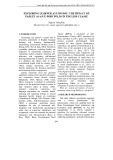
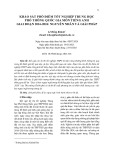
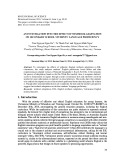
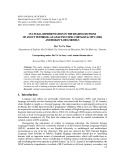
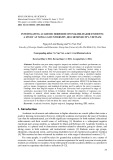

![Tài liệu Từ vựng tiếng Anh Trung cấp [mới nhất]](https://cdn.tailieu.vn/images/document/thumbnail/2025/20250913/nguyentuan250421@gmail.com/135x160/99491757910839.jpg)
![Tài liệu Từ vựng Tiếng Anh theo chủ đề [mới nhất]](https://cdn.tailieu.vn/images/document/thumbnail/2025/20250913/namdhuet@gmail.com/135x160/83251757753810.jpg)



![Tài liệu Từ vựng tiếng Anh cho bé [chuẩn nhất/mới nhất]](https://cdn.tailieu.vn/images/document/thumbnail/2025/20250731/huadaithesang2509@gmail.com/135x160/18631754013896.jpg)








